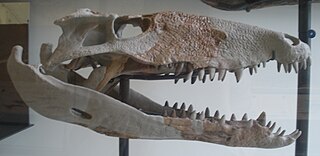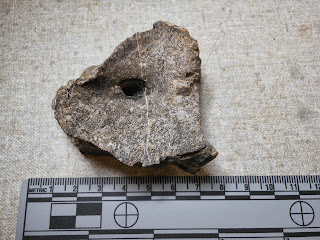Geological Setting and Tools of the trade
The rock that Bernie is found in was a large sandstone lens found in a shale formation. Sandstone lenses like this are commonly found layers between shale because of turbidite flows. Turbidite flows occur when an unstable slope underwater begins to move downslope, the moving material becomes fluidized, and the mass of water&solids moves downslope due to it's greater density. They commonly occur in deltas where sands and gravels are deposited at the mouths of rivers, creating over-steepened slopes that are unstable. Small triggers such as storms or earthquakes can cause these 'landslides' to occur. Some references are Wikipedia "
http://en.wikipedia.org/wiki/Turbidite " and "
http://en.wikipedia.org/wiki/High-density_turbidity_currents " . To see how the Suplee/Izee area developed geologically during this time you can check out this article:
http://pages.uoregon.edu/rdorsey/BM/LaMaskin_Intro.pdf " Bernie was found in the Izee terrane, the Brisbios member of the Vester formation. This formation has been dated as Carnian Triassic.
Here's a picture of a formation with repeated turbidite flows.

The sandstone Bernie is in was initially laid down in a near-shore environment, possibly where the influence of waves could still be felt. The sand is rather course, and there are scattered pre-existing rocks (clasts) scattered among the bones and shells. Some of the clasts are mudstone, limestone and chert. The limestone and chert were probably eroding out of Permian-age limestone hills of the Coyote Butte formation on land. These clasts also provide some challenge to discerning what is matrix (rock surrounding the fossils) and what is bone. In addition, there are lots of shells embedded in the matrix. Most are just broken-up shells which are not worth saving. However, some are fairly whole shells that are complete enough that we want to save them. We have recovered ammonites, gastropods, nautiloids, brachiopods, belemnites and a couple of bivalves. These invertebrates all have to be classified and should provide a good verification of the age of the formation.
This turbidite flow may help explain the dis-articulated nature of the bones - they are all mixed up. However, they can't have been moved very far since they are still close together. Perhaps they were formed in a delta environment, where overflows from a river bank can carry sediment a few yards and then bury it. Scattering and disarticulation by scavengers and wave action are also possible.
The sandstone is hard and well-cemented together. It is all cemented together by calcium carbonate. Acids erode the bone faster than the matrix so a chemical preparation is not possible. It requires power tools to remove it - hand tools just won't do the job. The main tool we use are air scribes, modified for fossil preparation. OMSI has several types of tools including Paleoscribe #5 and #2. I prefer to use my Chicago Pneumatic which I've modified to have different tips. The tips are made out of Tungsten Carbide drill bits with a stop brazed on and the pointy end sharpened on a diamond grinder. Here's some of the points. Conical points seem to work best on this matrix.
The larger tip, which is 1/8th inch in diameter (3.2mm) is used for aggressive removal. I consider it my "Destructo" tool. Here's a video of my larger tip in action:
The smaller tip (1/16th inch - 1.6mm) is used when working right up to the bone or shell surface. It doesn't remove rock so fast, but you can be more delicate and it has less percussive action. I find that keeping the tips very sharp helps immensely to speed up the process. I generally sharpen by bits at least once a day, and whenever I feel that I'm 'pushing' the bit into the rock instead of letting the tool do the work. The drawback to keeping the tool sharp is that it wears out faster - my 1/16th inch bits only last about 8 hours or so. But that's OK since I make my own and they only cost me about $10 or so. Here's how I sharpen them - the smaller bits take about 5 seconds!
There are generally three techniques I use. All the techniques use the fact that rock is weak in tension and strong in compression. The trick is use the weakness - the matrix must have a direction to flake off into open air. Pushing a tip straight in is like compressing the top of an arch - the matrix is all in compression and doesn't break. Putting the tip into the matrix about 1/16th or 1/8th inch beside an edge, and flaking the matrix off into the free space next to the edge works well.
For fast removal with little danger of bones I put the larger tip against the matrix held at about 45 degrees and push it into the matrix so as to create a groove. I generally follow parallel to other grooves. I have to keep constant attention for hidden bone. If I see a change in color or breakage pattern I stop and look carefully for the cause. Sometimes it's just a broken shell. If it's black I have to determine if it's a bone or a piece of black chert. The chert is harder than bone & the other matrix and it changes the sound or 'feel' of the tool action. Sometimes I just work around the black object to see the shape and size - the chert flakes are generally small while bone continues to a larger size.
For working on the bone surface there two techniques. Both require very small tips - the Paleo scribe #5 or #2, or my tool with a 1/16th inch bit. One technique I call the punch & flake. In this technique, I remove the matrix down to a layer about 1mm thick across the surface of the bone. Then I push down about into the matrix about 1mm from the edge of the rock. This puts sideways force on the small section of matrix and causes it to move sideways, fracturing off sideways from the bone surface. This cleans the bone surface well, and works best on dense bones with a solid surface. The tricky part is pressing down with the tip about 1mm from the surface, yet stopping the downward motion of the scribe before it touches the bone surface and leaves a pit. Total movement is generally 1/2 mm or less. I generally rest the heel of my palm on the specimen and rock my hand in & out (back & forth) to achieve this fine control.
The second technique works best where the bone surface is indistinct or gradually transitions from full matrix to full bone, sometimes over a depth of several mm. Imagine an broken and eroded end of a bone, the small internal structures sticking out but the solid bone surface missing. If you fossilize this, the outer edge of the bone is not distinct but is a gradual change from no bone to full bone. I hold the tip so that the tapered edge lies flat on the surface of the specimen and sweep it back & forth in an arc. The tip gradually sands away the matrix, allowing you to remove small layers of matrix less than 1/10 mm at a time in a controlled fashion. Remove matrix until enough bone structure shows up that you have the rough shape of the bone prepared. Remember, there is no distinct surface - this is a judgement call!
Sometimes, working in a matrix loaded with fossils, you have to be careful to remove them in an order that minimizes damage to underlying fossils. Here is a typical dilemma:
Generally I work around the bone undercutting it as deeply as I can while watching out for other bones appearing as I remove matrix. I remove as much matrix as I can, though sometimes you can't get it all out. Even using my finest bit, if bones are actually touching there is only so far you can go before you begin eroding one or the other. When I've taken as much as I can and it still doesn't come off I take a hammer and use a cold chisel as a wedge to try to break the upper bone up off the rock. Generally bones will separate along their natural surfaces if under tension. If they don't separate clearly, you work off the parts that remained and glue them back together!
More to come - Greg Carr





















































